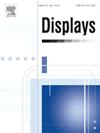GLDBF:用于无参照点云质量评估的全局和局部双分支融合网络
IF 3.7
2区 工程技术
Q1 COMPUTER SCIENCE, HARDWARE & ARCHITECTURE
引用次数: 0
摘要
无参照点云质量评估(NR-PCQA)是媒体质量评估领域的一项挑战,例如,由于点的结构比较分散,无法准确捕捉与质量相关的特征,而且现有的无参照 PCQA 指标较少同时考虑全局特征和局部特征。针对这些挑战,我们提出了一种用于无参考点云质量评估的全局和局部双分支融合(GLDBF)网络。首先,使用稀疏卷积来提取扭曲点云(PC)的全局质量特征。其次,提出了图加权 PointNet++ 来提取点云的多级局部特征,并进一步使用偏移注意机制来增强局部有效特征。此外,还提出了基于变换器的融合模块来融合多级局部特征。最后,我们通过多层感知器将全局和局部双分支融合模块联合起来,预测失真 PC 的质量得分。实验结果表明,在评估失真 PC 的质量方面,与现有方法相比,所提出的算法可以达到最先进的性能。本文章由计算机程序翻译,如有差异,请以英文原文为准。
GLDBF: Global and local dual-branch fusion network for no-reference point cloud quality assessment
No-reference Point Cloud Quality Assessment (NR-PCQA) is a challenge in the field of media quality assessment, such as inability to accurately capture quality-related features due to the unique scattered structure of points and less considering global features and local features jointly in the existing no-reference PCQA metrics. To address these challenges, we propose a Global and Local Dual-Branch Fusion (GLDBF) network for no-reference point cloud quality assessment. Firstly, sparse convolution is used to extract the global quality feature of distorted Point Clouds (PCs). Secondly, graph weighted PointNet++ is proposed to extract the multi-level local features of point cloud, and the offset attention mechanism is further used to enhance local effective features. Transformer-based fusion module is also proposed to fuse multi-level local features. Finally, we joint the global and local dual branch fusion modules via multilayer perceptron to predict the quality score of distorted PCs. Experimental results show that the proposed algorithm can achieves state-of-the-art performance compared with existing methods in assessing the quality of distorted PCs.
求助全文
通过发布文献求助,成功后即可免费获取论文全文。
去求助
来源期刊

Displays
工程技术-工程:电子与电气
CiteScore
4.60
自引率
25.60%
发文量
138
审稿时长
92 days
期刊介绍:
Displays is the international journal covering the research and development of display technology, its effective presentation and perception of information, and applications and systems including display-human interface.
Technical papers on practical developments in Displays technology provide an effective channel to promote greater understanding and cross-fertilization across the diverse disciplines of the Displays community. Original research papers solving ergonomics issues at the display-human interface advance effective presentation of information. Tutorial papers covering fundamentals intended for display technologies and human factor engineers new to the field will also occasionally featured.
 求助内容:
求助内容: 应助结果提醒方式:
应助结果提醒方式:


